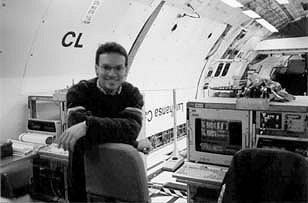TU intern - Dezember 2000 - Internationales
”This place was wonderful”A six month internship at Boeing
Ein sechsmonatiges Fachpraktikum bei dem amerikanischen Luft- und Raumfahrtkonzern Boeing war für Jasper P. Corleis ein einmaliges Erlebnis. Denn: Die Praktikanten haben im Rahmen des Stipendiums der Reinhardt-Abraham-Studienstiftung die Möglichkeit, zum Beispiel Flugtests selbstverantwortlich durchzuführen. 'v1 - rotate!' Could I believe it? I was sitting in the observer seat in the Cockpit of a Boeing 777-300 Test Airplane taking off from Paine Field, Everett. My task would be to observe all test conditions and to note every change of our configuration for a later check of the new-installed flight data recorder. But now we were taking off, swooshing through the thin-layered clouds over Seattle to go for a four hour flight which would take us over Oregon and California and in a wide loop high above the Cascade Mountains to Moses Lake, a remote airport in the desert-like surroundings of eastern Washington. I started my work at Boeing on May 23rd in Airplane Maintenance Data Engineering/Avionics (AMDE) which at this point of time was to merge with Maintenance and Ground Operations (MGOS) to Maintenance Engineering Technical Services (METS). The task of the group I became part of was to produce and update the Maintenance Manuals and the Manuals for unscheduled Maintenance such as the Fault Report Manual (FRM), Fault Isolation Manual (FIM) and the Dispatch Deviation Guide (DDG). Most of the work in this department was the intermittent revisions for the different models of 737 to 777 and change requests mainly originated by customers. Here I made my first experiences with the American way to work, basically how work was done. Since I had worked for two an a half years as a working student at BMW Rolls-Royce Aeroengines, I already was familiar with meetings, telecons, or English as the workplace language. But now most of the working environment was new to me. A typical Boeing Office was a Cubical arrangement around either four or eight desks. I found it was pretty easy to get used to it - since there was much more communication going on than I had experienced in Germany. Meetings were held very spontaneously within the cubicals and for everybody to follow. But my real desire was to fly the airplanes. So in early August I started my work in Flight Test where I worked for the remaining four months. Working here was completely different. Located right at Boeing Field I basically walked through hangars to get to my office. During the first days the 767-400 which was to go on the World Tour was the first thing I saw. From the window of my office I could see the whole Boeing Field, Mt. Rainier and all the traffic going to or from Seatac Airport. Every departure or arrival was announced via loudspeakers - this place was wonderful! I was in the Avionics/Navigation/Communication and Auto Flight Department of Flight Test Engineering (FTE) which is a division of airplane validation and flight operations. My department actually consisted of four people : my Supervisor Byron, my lead Danny and my colleagues Duc and Ray. The Mission statement of FTE was to perform flight tests to provide information for design development, design confirmation, certification and safe, efficient operation of Boeing airplanes. That included both experimental and production airplanes. On my first day at FTE I was allowed to participate in a test of a 737-700 SATCOM System which I found amazing. And on the next day my lead asked me if I already had written the test summary. This was real work from the first day on! I very quickly became a fully integrated member of our team, had my own responsibilities and my own tests. Usually a test was kicked off by an EWA, an Engineering Work Authorization which defined the scope of the test. Out of this EWA it was my responsibility to create a Test Item Plan consisting of a risk assessment, a configuration set-up, test prerequisites and the test conditions. If the test was leading to a FAA Certification it required a Test Specification submitted to the FAA. In close contact with Test Operations a test date was set. At the test itself my responsibility as the Flight Test Engineering Analysis Engineer was to witness the test and to summarize and report its result to my group, operations and the FAA. Even though my colleagues had trusted me right from the beginning the responsibility even grew. So I was allowed to go on test flights not only as the responsible FTEA Engineer but as a representative for my lead as DER (Designated Engineering Representative) who is allowed to sign test results on behalf of the FAA. And finally, I was allowed to conduct two 737NG and one 757 certification flight tests as the Test Director, responsible for the complete flight testing. All this was the formal work on flight test. But there was a lot more to experience. The beauty and the amazing diversity of the landscape I could see during the flights was fascinating. Seattle is almost enclosed by the Olympic Mountains in the west and the Cascade Range from northeast to southeast. In cloudy weather the clouds often remain hanging in this valley because the mountains function like a natural barrier. Jasper P. Corleis Leserbriefe |
|
TU intern - Dezember 2000
|
||
